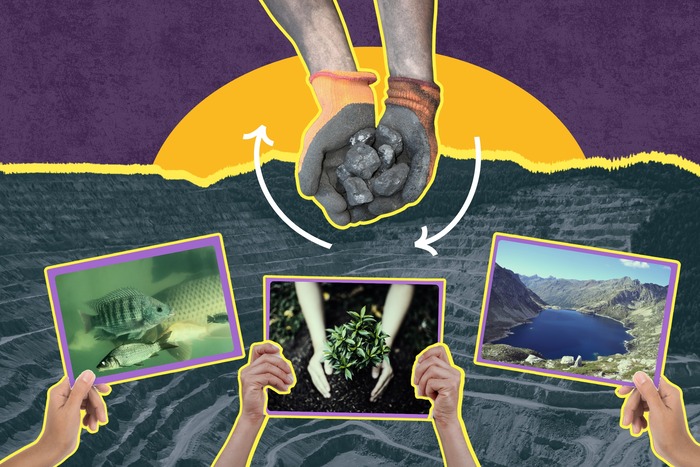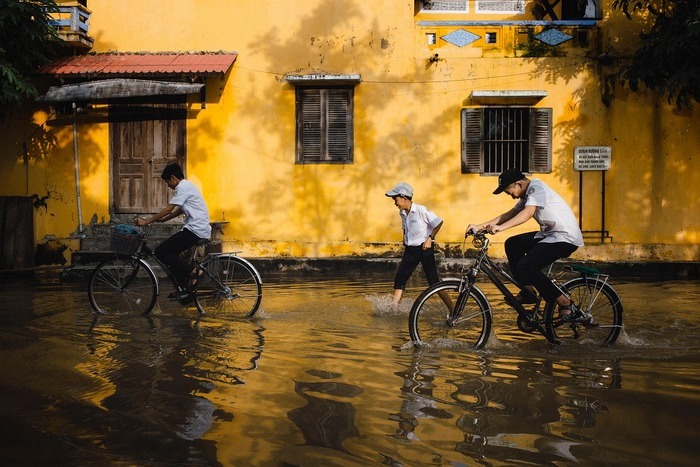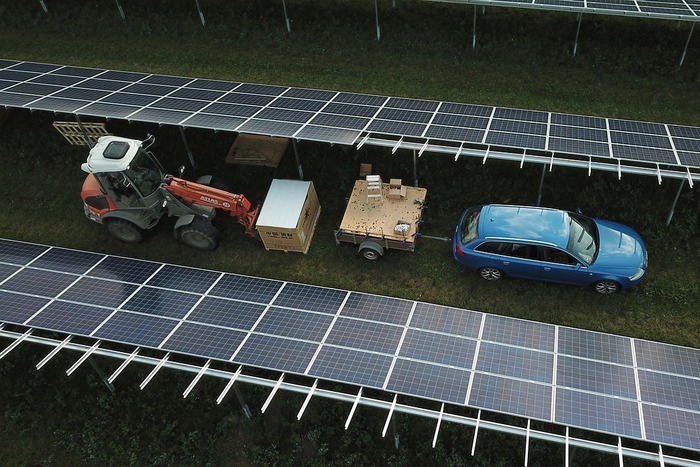
Visuals: Riddhi Tandon
From extraction to regeneration: How India’s coal mines are being reimagined
Pisciculture, afforestation, pumped storage, eco-tourism have emerged as the more popular forms of re-using abandoned mines
Barely five hundred metres after crossing the Damodar river near Jharkhand’s Bhurkunda town, a leaf-strewn path branches out from the main road to Saunda, a coal town in Ramgarh district. This almost missable path, lined with sal trees, slopes downward towards the former coal mine in the Barkasayal area. It’s now used for harvesting fish.
Owned by the Central Coalfields Limited (CCL), the open cast mine was shut around four decades ago, and got inundated with groundwater. On top of this, floodwaters from the Damodar and the smaller Nalkari river, about a kilometer away, filled up the mine, creating an artificial lake.
This became the ideal place for pisciculture for local Rajdev Yadav and his peers in November 2023. They currently operate the fish farm within 6 acres, using 48 cages. This employs 57 people, including women.
“With coal mines gradually closing, we were becoming unemployed. During the pandemic, there was no work. We wanted something of our own through which we could earn a livelihood,” says 52-year-old Yadav, who is the secretary of the society.
An influential person in his village, Yadav used to work as a small-time, daily labour contractor in the mines, handling physical loading and unloading of coal onto trucks. But as machines started replacing men for this work, he started looking for alternative incomes and ventured into pisciculture.
India’s coal regions face an uphill task of ensuring people retain livelihoods as the energy transition takes place, as CarbonCopy previously reported. Such initiatives can go a long way in smoothening the just transition process.
Besides Saunda, fish farms have sprung up in 15 such abandoned mines across the districts of Hazaribagh, Ramgarh, Ranchi, Bokaro, and Chatra.
Coal India Limited (CIL) has also explored other ways of repurposing shut mines by turning them into tourism sites, or afforesting and reclaiming these areas for agriculture, generating sand, and even supplying water for drinking and domestic uses from water-filled mines.
In Jharkhand alone, there are around 1,741 such abandoned coal mines. The potential for transforming unutilised mines to a productive enterprise that generates employment is immense. Especially in India’s coal regions, which are facing negative fallout from the energy transition, as the green energy and clean tech industries are springing up either in non-coal regions, primarily in west or south India.
In fact, the central government is also appreciating this potential. Recently, Prime Minister Narendra Modi called for 143 mines across the country to be closed in an eco-friendly manner, which can then be used by local farmers.
However, there are concerns about the presence of toxic chemicals in these mines, which need to be removed or treated before they can be re-used for any purpose.
Transformation
In Saunda, that is precisely the case. Locals from three nearby villages came together to form a society — Maa Bhavani Matasajibi Sahyog Samiti Limited, for the explicit purpose of pisciculture.
“We wrote to the fishery department, and asked for a NOC (no objection certificate) from CCL. The fishery department advised us to make a society of the people who want to work on the abandoned mine, and that’s how the society came to be,” says Yadav.
While the Central Saunda Pisciculture Project in the Barkasayal area employs 57 people directly, indirect benefits reach around 250 local villagers. Men work in shifts throughout the day, while women prefer the afternoon shifts, when they get a respite from household and other work.
Just metres from the water’s edge, the villagers have set up a big tent with chairs and a bed. The tent doubles as a resting pit and a storeroom of varied fishing equipment like nets, and fish feed. From there, one can see a vast expanse of the artificial lake, crisscrossed by metal cages where the fish are reared. To reach the cages, the locals use a custom-made raft fashioned from plastic drums, which can carry over a dozen people and heavy bags of feed.
It took three months to install the cages, while the fish took even longer to grow enough to be harvested. These expensive cages, measuring 12 x 8 x 5 metres, were supplied to the fish farmers at 90% subsidy, according to Yadav. The district commissioner provisioned the financing from the District Mineral Fund, and the government even provided feed and breeding fish to start off.
In the first year, the society lost about 10 tonnes of fish due to over-breeding. Oxygen supply in the water reduced, leading to fish deaths, but Yadav chalks it up to lack of experience. Last year, however, they sold 42 tonnes of fish, mainly tilapia, and kept a profit of roughly ₹20 lakh. While most of it will be split up among the society’s members, a chunk will also be reinvested in the business, mostly for buying fish feed.
“Although we are learning, this is definitely better than working at coal mines,” says Yadav, sitting in the tent, while his peers nod in agreement. “This fishery has potential for employing around 150 people if it can be utilised properly,” he says.
For developing fish farms in coal mines, this paper published in the International Journal of Ecology and Environmental Sciences outlines certain processes that will support the growth of fish — flooding with surface water to improve water quality, use of submersible pump aerators to increase dissolved oxygen in the water, and application of manure to increase nutrient content.
In fact, the paper’s findings included that the cattle manure enhanced production of fish food, while the fish itself could grow up to 1.5 kg in eighteen months, primarily catla or the Indian carp.
The water, too, needs to be suitable for pisciculture. First, checks need to be run to ensure there aren’t any toxins like lead and arsenic. If clean, then it needs to be treated to make it suitable for pisciculture, or even diverting for irrigation or supplying to households, says a senior mine closure expert, who wished to remain anonymous.
“It is a misconception that coal mine water is toxic. There are methodologies for treating it, based on government prescribed standards. Any use of mine water is allowed only after meeting environmental clearance conditions as set by the MoEFCC (Ministry of Environment, Forests and Climate Change),” he says.
Regarding treatment techniques, he says that water in mines appears black because of coal. “It is suspended particulate matter, and it settles through sedimentation after some time. So, the water treatment is required only for suspended solids. 95% of our mines are non-toxic, and the water quality is good. With continuous, moderate treatment, the water can be utilised,” he says.
Close to Saunda, an even older such society has been fishing in the waters of the Ara coal mine since 2010. The 68-member Kuju Fishermen Cooperative Society, which also received a ₹4-crore cage infrastructure, funded through government subsidy, boasts of 126 cages in which 40 tonnes of fish were harvested last year.
The average selling price of a tonne of fish is around ₹1 lakh, according to Yadav.
Multiple uses
According to a paper published in ScienceDirect, the uses of abandoned mines are varied — from industrial tourism to energy generation through pumped storage, wind, and compressed air.
“It all depends on the mine’s location, as the same solution is not fit for all areas,” says Ashwani Ashok, director of just transition at the think-tank Center for Environment and Energy Development (CEED).
His view is that overburden (OB) — the excavated earth from the mine which is dumped beside the dug out area, forming a hill — has diverse uses in a repurposing scenario. Especially since the mainstay of coal mining today is open cast, which generates a lot of OB.
“The OB soil has a lot of stones, which are converted to sand, and then supplied to the construction industries. Another option is to use the OB for ground mounted solar. But it is only possible when the OB is firm, and does not disintegrate,” says Ashok.
The workaround is planting shrubs and vegetation to bind the OB soil, making it stronger and greener.
He believes that building solar capacity will also attract allied industries, like raw material suppliers, solar panel makers and assembling units, which will in turn generate employment. It will also secure Jharkhand’s energy needs, and the state need not import power.
“Mostly, reuse of mines are being done with the aim of just transition, as there are a lot of informal workers involved. The whole economy can’t be changed, especially in a coal-dependent state like Jharkhand. If you can’t provide jobs, then people will migrate. People need some income generating opportunities in their areas too,” says Ashok.
As for pisciculture’s popularity, Ashok’s reasoning is that it is generating enough revenue to employ a substantial number of people. “From Ramgarh, they are exporting fish to other states like Bihar, Bengal. It is not dependent only on people who were directly employed in coal work. Incomes from pisciculture and informal coal labour are comparable, and can even be better,” he says.
In Yadav’s village, people who are not farming fish are either engaged in contractual work for private coal companies or daily wage labourers in the construction industry. The rest have migrated to bigger cities. But the question remains why all villagers are not jumping on the pisciculture bandwagon, especially as it is giving substantial returns?
Pisciculture does not pay out daily wages, and most people in such areas are used to earning daily, according to Yadav. “In fishing, one sees earnings only after the harvesting period, which can take a few months,” he says. And how many people can afford to wait a few months before seeing any income?
Besides pisciculture, two other big usages of abandoned mines are eco-tourism and afforestation efforts for creating carbon sinks. The latter, however, does not create a continued income stream for locals, besides when they are hired for planting saplings and watering them in the initial stages, says Yadav.
“Sustainable development can happen if the coal has been mined out, and the OB has been levelled. After that, afforestation is possible, as well as presenting the mine as an eco-tourism site,” explains R Munda, project officer at another abandoned mine, Saunda D, roughly 6 km away from Central Saunda.
While Saunda D is being leased to a private company for digging out more coal in India’s quest to increase coal production, as CarbonCopy reported earlier this year, Munda reveals that an eco-tourism park is being built in Bhurkunda itself.
However, pumped storage in abandoned mines has not yet been explored in this region. Water from the abandoned mines in Bhurkunda have been pumped out, treated for drinking and domestic purposes, while some have been channeled into irrigation and dust control, according to Munda.
As of February 2023, Coal India had converted 30 abandoned mines into eco-tourism sites across the country, including Kenapara Eco Park in Chhattisgarh and Ananta medicinal garden in the Talcher Coalfields of Odisha. The afforestation measures also helped the company to surpass its plantation target of 1510 hectares by 100 hectares in FY 2022-23.
In fact, according to government data, Coal India has planted over 30 lakh saplings in FY23, and managed to afforest 4,392 hectares within the boundaries of the mine-leased areas. This resulted in the carbon sink potential of 2.2 litres/year.
As of April 2021, the Coal Ministry had identified 293 abandoned mines across the country for closure or reuse.
In the USA, which has about 550,000 abandoned mines, efforts are underway to convert them to ‘gravity batteries’ for energy storage, while the erstwhile coal belts in Appalachian mountains and the western part of the country are being explored for setting up AI (artificial intelligence) data centers, which need large chunks of land.
Elsewhere like in Germany, efforts are being undertaken to utilise mines as a lower reservoir for underground pumped storage hydropower (UPSH), as well as for compressed air energy storage (CAES), heat storage and geothermal power generation.
India is also toying with the idea of pumped storage in abandoned coal mines with Coal India identifying 20 such mines for evaluation and feasibility for pumped storage.
Last month, the Singareni Collieries Company Limited (SCCL), announced that it is planning to set up a 500 MW pumped storage project at the closed Medipally open cast mine in the south Indian state of Telangana. It is expected to cost around ₹3,000 crore and can produce energy at low cost for 40 years.
But pumped storage cannot be possible everywhere, as sufficient incline is required, says the mine closure expert. Now, if the height between the highest point on the OB and the dug out mine is sufficient — around 50-60 metres, then pumped storage is feasible, he says.
“During daytime, a solar pump brings up the water to the OB dump, where a water reservoir is created. At night, the water is released to the lower mine level through pipes. This rotates the turbine, generating electricity,” he says, adding that CIL is running a few pumped storage pilot projects, and it will be taken up on a larger scale if they are successful.
Questions mailed to Coal India on this remain unanswered. The copy will be updated once CarbonCopy receives the responses.
Urban forests
A different, but ingenious use of abandoned mines can be found more than 1,700 km north of Medipally, in the heart of India’s capital, Delhi. The 692-acre Aravalli Biodiversity Park, stretching out lushly amidst the concrete structures of Vasant Kunj in South Delhi, was built on an abandoned open-pit quarry.
The mines have a depth of around 30 feet on average, while some go as deep as 100 feet, and their diameters could be around 200-250 metres, says Dr. Mohammad Shah Hussain, director of the Aravalli Biodiversity Park.
His 5-member team began work on the degraded piece of land in 2004. “There were damages to topsoil, soil regimes, groundwater percolation which resulted in degraded, barren land. Our aim was to bring back native vegetation. In 20 years, we have restored 450 acres of land,” he says in his office in the middle of the park.
Outside, earthy trails lead to differently restored sites, including medicinal gardens, orchid and fern conservatories, grasslands, as well as a showcase of the native plant species found historically in the Aravallis.
The primary challenge faced by these scientists was the different climactic conditions in the mining pits, as they are at different depths, which changed the temperature and moisture gradients.
Accordingly, they had to study which type of plants would grow at what level of the mines, and then plant seeds for optimal growth. Naturally, herbs and shrubs growing at the lower temperatures in the depth of the mines would be different from the big trees planted for shading at the top of the mines.
Indeed, walking for an hour around the park, the temperatures changed by quite a few degrees, depending on which level of the mines one was in. Deep down, it was more damp and cool, where plants which favoured shade thrived, while higher up, the climate was hotter and sweat inducing.
“We have planted over 22 plant families, which have spawned over 900 species of plants. Now, birds and butterflies have started coming back. We have spotted around 115 types of butterflies, 215 bird species, and 29 reptile species. The more diverse it becomes, the more animals and birds are attracted to it,” says Dr. Hussain.
Since there were some wetlands also in the area earlier, Dr. Hussain’s team created water holes inside the park to mimic natural water bodies which can meet the water requirements of the animals foraging the park, as well as help in regenerating groundwater.
According to Dr. Hussain, animal species like the Indian pitta, pied hornbill, black eagle, Eurasian griffon vulture and the leopard gecko — former natives to the Delhi region, were spotted again after the Aravalli Biodiversity Park was restored.
Migratory birds from the Himalayas and south India are also flocking to the park, staying longer as the place is cooler compared to neighbouring areas, while the shaded, cooler temperatures of the deeper mines attract nocturnal animals like the porcupine, jackals and civets.
“A biodiversity park mimics a national park. There are multiple benefits of having such a park in a city — groundwater regeneration, clean air, and carbon capture and sequestration,” says Dr. Hussain.
Such restoration of biodiversity requires scientific intervention, and is not easy, especially when being done in abandoned mines, offers Debadityo Sinha, senior resident fellow and lead of the Climate and Ecosystems team at the Delhi-based Vidhi Centre for Legal Policy.
“Removing chemicals and toxic elements from the mines are crucial before attempting restoration. If no disturbance can be ensured, then a forest will grow naturally over time, especially if there is a forest nearby,” he says.
“Mines can be cooler if there is canopy, good wind and contains water, which will attract animals. But in order to restore biodiversity, growing plants and grass is important. That will attract herbivores, which will attract carnivores, leading to proper restoration,” says Sinha.
A rapidly warming planet is bringing a host of problems like extreme heat, depleting water resources, and making cities unlivable, as CarbonCopy reported earlier. Targeted interventions like afforestation, building urban parks can help mitigate some of the problems like reducing temperatures and regenerating groundwater.
In less populated areas, where locals are dependent on jobs in coal mines, revamping old, abandoned for commercial purposes like fishing can ensure that locals have alternate livelihoods, and do not end up victims of a transitioning economy.
While repurposing old mines may not be an uniform solution for the different set of climatic and development issues plaguing India, it can at least ease some of the burden.
Flash floods. Photo: Pixabay
Flashfloods: 3 dead in Himachal, eastern Rajasthan on red alert, very heavy rain in Western MP, Bihar
Three people were killed in flash floods triggered by heavy rainfall” in the Himalayan gateway town of Mandi as “gushing” flood waters flowed through the city, the Indian Express reported. The newspaper quoted state authorities stating that Mandi has become “the epicentre of disasters” in Himachal Pradesh, in a region that has seen “intensifying climate volatility” in recent years.
IMD issued a red alert of very heavy rainfall in eastern Rajasthan, and warned of heavy to very heavy rainfall in western Madhya Pradesh, Bihar, and different parts in Himachal Pradesh, DTE reported
In Madhya Pradesh Bhopal received 117.7 mm rainfall in just over a day breaking past records, weather office said, while issuing a warning of very heavy rainfall, thunderstorm and lightning for Bhopal, Vidisha, Sehore, Rajgarh, Betul, Khandwa, Dewas, Shajapur, Guna, Shivpuri, Narsinghpur, Chhindwara and Pandhurna districts, reported TOI.
Glacial bursts and cloud bursts kill 293 in Pakistan
Pakistan recorded 293 deaths and over 600 injured since late June, “as glacial lake outbursts, cloudbursts and relentless monsoon rains triggered catastrophic floods, from the Himalayas to the south plains”, the Times of India reported. Forecasts of another severe monsoon spell have “rais[ed] fears of fresh flash floods and landslides”, the newspaper said, noting that experts “blame successive gov[ernments] for ignoring climate adaptation and disaster preparedness, despite warnings”. Thousands of people were forced to evacuate their homes because floodwaters from the Indus and Chenab rivers have “inundated more than a dozen villages” across Pakistan’s Punjab province, reported the newspaper Tribune.
Over 1,000 dead in rains till July 16; Andhra logs most monsoon deaths
India recorded 1,297 deaths due to intense rainfall between April 1 and July 16, 2025. Andhra Pradesh suffered the highest toll of 258, followed by 171 deaths in Himachal Pradesh, 148 in Madhya Pradesh, and 101 in Bihar, ministry of home affairs informed the Lok Sabha, HT reported.
It added a total of 51,699 cattle were lost, 92,663 houses damaged and 154,394.27 ha cropped area affected during the period. Himachal recorded a loss of 23,818 cattle and 1,528 homes, M.P. lost 325 cattle and 986 homes. Assam recorded the highest damage to cropped area covering 29,714.89 ha.
“Due to highly favourable synoptic systems and monsoonal winds, central and western parts of India, have experienced heavy rainfall spells, leading to excess to large excess rainfall over these areas, due to which early flood incidents have also been reported,” the newspaper reported the Centre saying.
Himachal Pradesh recorded a loss of 23,818 cattle and 1,528 homes, MP lost 325 cattle and 986 homes. Assam recorded the highest damage to cropped area covering 29,714.89 ha.
Climate change is redrawing flash flood maps in India: IIT Study
A new study by IIT Gandhinagar warned that manmade climate change is carving new flood-prone regions in areas once considered very safe. The study, titled “Drivers of Flash Floods in the Indian Subcontinental River Basins” said flash flood hotspots are expanding beyond traditionally vulnerable zones into drier and semi-arid regions, New Indian Express reported.
The study observed a marked rise in flash floods across semi-arid zones of western India, regions previously seen as low-risk, caused by an increase in sub-daily precipitation events and heat, which increases moisture and triggers intense rainfall.
Even sub-basins earlier considered low in susceptibility are now showing significant increases in both precipitation and streamflow. The researchers compared data from 2001 to 2020 with a baseline of 1981–2000 and found a sharp rise in wet hours — a key driver of flash floods — across all Indian river basins not previously categorised as prone, the outlet noted.
The proportion of non-flash flood-prone sub-basins with increased rainfall and streamflow grew from 51% to 66.5% in the past two decades, the study said. Similarly, the areas currently classified as highly susceptible to flash floods are seeing a reduction in precipitation and streamflow, indicating a potential future shift in flood hotspots. The percentage of wet hours in these zones declined from 50.3% to 48.7%, the study said.
According to the National Disaster Management Authority (NDMA), over 40 million hectares of land in India are prone to floods. Flash floods remain one of the deadliest forms of flooding, causing over 5,000 deaths annually.
Flood and heatwave risks increasing in urban India, $2.4 trillion investment required: World Bank
According to a new World Bank report, India will need “over $2.4 trillion by 2050” to develop “resilient, low-carbon infrastructure” to adapt to rising climate impacts in its expanding cities, reported HT. The outlet noted that prepared in partnership with India’s urban affairs ministry, the report estimated that by 2050, heat stress could reduce working hours by 20% and heat-related deaths “may rise to more than 328,000 by 2050” if emissions continue at current levels.
The World Bank estimates that urban flooding – which currently costs India 0.5-2.5% of its gross domestic product annually – “will double under a global high-emission scenario”, LiveMint reported. The outlet noted that the fact that more than half of India’s urban growth (in terms of new built infrastructure) “is yet to come” can be “a huge opportunity to…avoid large future damages and losses from climate and disaster impacts”.
India’s forests are “less able to convert greenness into actual carbon uptake”
An IIT study found that Indian forests’ ability to photosynthesise has been impaired by rising heat and dryness, making it harder for them to do their job, reported TOI.
The outlet noted that India’s forests are greener than they were two decades ago. But that’s not a reason to celebrate. “In fact, it may be providing a deceptive cover to a deeper climate crisis.” the newspaper said. A landmark study by two scientists at IIT Kharagpur revealed that even as greenness and leaf cover have increased for Indian forests, their ability to absorb and store carbon dioxide — a critical function in the fight against climate change — is deteriorating, the newspaper reported.
Land remains a blind spot in tracking progress under the Paris Agreement due to lack of data comparability
According to a new study published in Nature, greenhouse emissions from land use are a blind spot that leave countries uninformed of the 2030 gap between their ambitions for mitigation on land and models’ benchmarks.
The study said land carbon fluxes are key to the Paris Agreement, but data comparability issues persist between countries’ land greenhouse gas inventories and mitigation targets, and what land models (bookkeeping and integrated assessments) provide as Paris-aligned benchmarks for land. As a result, the Global Stocktake, aiming to track collective mitigation progress, did not explicitly consider country targets for land.
Top UN court says treaties compel wealthy nations to curb global warming
The International Court of Justice (ICJ), the UN’s highest court, has told “wealthy” countries “they must comply with their international commitments to curb pollution or risk having to pay compensation to nations hard hit by climate change”, reported Reuters. The ICJ ruled yesterday that countries must address the “urgent and existential threat” of climate change, in an advisory opinion that is being hailed by small island states and environmental groups as a “legal stepping stone to make big polluters accountable”, the newswire said.
The Print said India had a hand in the landmark ruling: “In its written and oral submissions, India underscored the principle of common but differentiated responsibilities. It argued that wealthy nations that grew rich through carbon-intensive development must not only cut emissions first, but also provide new and additional climate finance, technology transfers, and support for adaptation and loss and damage.
The ICJ largely agreed. Its opinion stresses that the duty to prevent environmental harm extends beyond borders, that this duty is one of conduct (not merely intent), and that failure to mitigate risks, even by omission, can amount to a breach of international obligations.”
Trump imposed 25% tariffs on India. Photo: Wikimedia Commons
Day after he imposes 25% tariff, Trump says India-Russia can ‘take their dead economies down together’
US president Donald Trump targeted India and Russia over their trade and ties, saying the two countries could “take their dead economies down together”. In a post on Truth Social he wrote: “I don’t care what India does with Russia. They can take their dead economies down together, for all I care. We have done very little business with India; their Tariffs are too high, among the highest in the World. Likewise, Russia and the USA do almost no business together.”
He also warned former Russian President Dmitry Medvedev to “watch his words” and avoid entering “very dangerous territory”.
Medvedev, on July 28, had posted in X: “Trump’s playing the ultimatum game with Russia: 50 days or 10… He should remember 2 things: 1. Russia isn’t Israel or even Iran. 2. Each new ultimatum is a threat and a step towards war. Not between Russia and Ukraine, but with his own country. Don’t go down the Sleepy Joe road!”
India in its initial official response said it will take care of its national interest: “The Government has taken note of a statement by the US President on bilateral trade. The Government is studying its implications. India and the US have been engaged in negotiations on concluding a fair, balanced and mutually beneficial bilateral trade agreement over the last few months. We remain committed to that objective,” the Ministry said in a statement issued Wednesday evening.
India said the government places the “utmost importance on protecting and promoting the welfare of” farmers, entrepreneurs, and MSMEs.
Permission to clear forest to last ‘till the life of the coal mine’
Centre extended the validity of forest clearances to match with the validity of coal mine leases granted under the Coal Bearing Areas (Acquisition and Development) Act, 1957, according to a letter it issued to all states and UTs earlier this month, reported HT.
Earlier forest clearances for coal mine leases could be granted for a maximum period of 30 years. The Chhattisgarh government had sought clarification on extension of validity of approvals granted under the Van (Sanrakshan Evam Samvardhan) Rules, 2023 to coal mining projects, according to documents seen by HT.
The newspaper continued: “The matter was thereafter discussed by the Forest Advisory Committee of the environment ministry. The meeting discussed that as per the provisions of the Coal Bearing Areas (Acquisition and Development) Act, 1957 and a clarification provided by the ministry of coal in a letter dated May 19, validity of coal mining projects/leases of state-owned companies, acquired under the CBA is perpetual i.e. once the lease is granted it remains valid till the life of the coal mine.”
India forms panel for COP-33 that it proposed to hos
India’s environment ministry set up a “dedicated COP33 cell” to prepare to host the UN climate talks in 2028, although its bid is yet to be officially accepted, PTI reported. The environment ministry set up the cell to address the professional and logistical requirements for COP 33. If accepted by the UNFCCC, COP 33 would be the second UN climate conference to be hosted by India after COP 8 in New Delhi in 2002. It would follow India’s successful presidency of the G20 summit in 2023 and position the country at the centre of global climate negotiations.
Leaders of the BRICS nations, at the 17th BRICS Summit held earlier this month, welcomed India’s candidacy to host Cop33. A joint declaration said: “We express our full support to the Presidency of the UN Framework Convention on Climate Change Cop-30, which will take place in Belem, Brazil, highlighting the importance of action and cooperation on all pillars of the UNFCCC as applicable, considering each country’s membership and commitments thereunder. We also underscore our full commitment to a successful Cop30 that will catalyze progress in implementing the UNFCCC and its Paris Agreement. We welcome India’s candidacy to host Cop33 in 2028.”
More than 368,000 trees could be felled for a coal mining project in “one of India’s last remaining old-growth forests”
Centre told Parliament over 368,000 trees “will be affected” due to the Parsa East Kente Basan (PEKB) coal mining project in Chhattisgarh’s Hasdeo Arand, one of India’s last remaining old-growth forests, reported HT. Minister of state for environment Kirti Vardhan Singh told Lok Sabha provided written information on the tree felling in response to Communist Party of India (Marxist–Leninist) Liberation lawmaker Raja Ram Singh’s question.
The newspaper said, the lawmaker from Bihar asked whether the government was aware that over 200,000 trees had been felled for the Adani Enterprises project. He sought details of the felling and whether environmental clearance was granted despite local opposition, tribal rights claims under the Forest Rights Act, 2006, and the ecological sensitivity of the region. The lawmaker asked for the reasons for permitting extensive deforestation in a biodiversity-rich forest despite the climate crisis.
The outlet in January 2022 reported the environment ministry permitted further coal mining on 1,136 hectares in Hasdeo Arand despite protests. The ministry’s forest advisory committee on December 23 approved a proposal to extend mining in Rajasthan’s power distribution utility-owned PEKB block, as coal reserves in the first allotment of 762 hectares were exhausted earlier than estimated.
EU and China pledge climate leadership role as US retreats
At their recent summit, the EU and China declared they would “lead the world in the fight against climate change”, according to a joint statement quoted by Bloomberg. Both sides committed to submitting updated climate plans for 2035 that align with the Paris Agreement’s long-term temperature goals—well ahead of COP30 in Brazil. They also agreed to deepen cooperation on the energy transition and reducing methane emissions. The New York Times reported that the summit found “common ground on climate change”, adding that the statement was “conspicuously silent on trade issues, including electric cars”.
US: EPA moves to end climate regulation under Clean Air Act
The Trump administration made the Environmental Protection Agency (EPA) release a plan to revoke the scientific finding that underpins the government’s regulatory authority to combat climate change, reported Washington Post. The repeal of the “endangerment finding” would end EPA regulations on power station emissions, the control of the release of methane by oil and gas companies and pollution from cars and trucks, the newspaper said adding that : “The EPA’s new proposal argues that Congress, in the Clean Air Act, does not give the agency the authority to regulate greenhouse gas emissions. If the rule takes effect, it would immediately reverse the vehicle regulations and spark a legal battle that probably would take years. Should the Trump administration prevail in court, the rule would severely limit the ability of future presidents to curb fossil fuel emissions.”
The New York Times said the proposal is the “most consequential step yet to derail federal climate efforts and appears to represent a shift toward outright denial of the scientific consensus”.
News channel CNN reported that the repeal is “based in part on a hastily produced report – authored by five researchers who have spent years sowing doubt in the scientific consensus around climate change – that questions the severity of the impacts of climate change”.
Japan takes step towards first post-Fukushima nuclear energy reactor
A Japanese utility has become the first since the Fukushima nuclear disaster 14 years ago to take steps towards building a new reactor, the FT reported. The newspaper added: “Kansai Electric Power said on Tuesday it would resume a survey into whether it could build a new reactor at Mihama in Fukui prefecture. The project had been suspended after a tsunami in 2011 caused the country’s worst nuclear power accident. Resuming the review marks the first push by a Japanese power company to advance concrete plans to construct a nuclear energy plant from scratch since the disaster.”
COP30 must make good on past climate commitments
Former New Zealand prime minister Jacinda Ardern, former UN under-secretary-general Carlos Lopes and former French ambassador and current European Climate Foundation CEO Laurence Tubiana wrote for Project Syndicate saying that Brazil’s COP30 presidency “must eschew flashy results in favour of pragmatic pathways to deliver on past agreements”.
They said: “Fortunately, Brazil recognises this. Its fourth letter to the international community outlines an action agenda aimed at making progress on what the world has ‘already collectively agreed’ during previous COPs and in the Paris climate agreement. Specifically, the agenda seeks to leverage existing initiatives to complete the implementation of the first ‘global stocktake’ under the Paris Agreement, which was concluded at COP28. This focus on previously agreed outcomes is well-suited to the current geopolitical context, in which any agreement can be difficult to reach.”
Landfills. Photo: Pixabay
NGT seeks clarification from MCD on waste management at Ghazipur landfill
After the Municipal Corporation of Delhi shared its plan to clear the Ghazipur landfill by 2028, the National Green Tribunal (NGT) asked for clarity on lapses in waste management, the waste-to-energy (WTE) plant there and leachate management, saying the untreated waste was adding to the legacy waste at Ghazipur, reported TOI.
While pointing out that the operational capacity of the WTE plant was 800-850 tonnes per day, NGT asked the civic body to explain how 700-1,000 tonnes were reaching Ghazipur WTE. “MCD needs to disclose the plant’s actual capacity and consented utilisation, along with the supporting materials such as daily electricity generated by it and the details of its utilisation/feeding into the central grid,” the tribunal said.
Commenting on MCD’s report on its plan to clear the Ghazipur landfill by 2028, the court said: “Though the dump site receives waste in the range of 2,400–2,600 tonnes per day, it is presently processing a much lesser quantity. Therefore, the untreated waste is adding to the legacy waste. The WTE plant in Ghazipur is presently utilising only 7,00-1,000 tonnes of waste daily.
NGT issues notices on alleged plastic waste violations by tobacco brands
The National Green Tribunal (NGT) issued notice on a plea alleging widespread non-compliance with the Plastic Waste Management Rules, 2016, by manufacturers of gutkha, pan masala, and tobacco products, reported ET.
The petition claimed that banned plastic packaging materials are still being used and calls for strict enforcement of existing regulations. This includes the closure of units violating the rules and the recovery of environmental compensation. A judicial bench led by Justice Prakash Shrivastava and Expert Member Dr. A. Senthil Vel has issued notices to relevant authorities, including the Central Pollution Control Board (CPCB) and the Delhi Pollution Control Committee (DPCC), seeking their responses.
Gas flaring created 389m tonnes of carbon pollution last year, report finds
Oil companies pumped an extra 389m tonnes of carbon pollution into the atmosphere last year by needlessly flaring gas, a World Bank report found, in an “enormous waste” of fuel that heats the planet by about as much as the country of France, Guardian reported.
Flaring gets rid of gases such as methane that arise when pumping oil out of the ground, the outlet explained, adding that while it can sometimes keep workers safe by relieving buildups of pressure, the practice is routine in many countries because it is often cheaper to burn gas than to capture, transport, process and sell it.
Global gas flaring rose for a second year in a row to reach its highest level since 2007, the report found, despite growing concerns about energy security and climate breakdown.
It found that 151bn cubic metres (bcm) of gas were burned during oil and gas production in 2024, up by 3bcm from the year before.
Only 0.5% of 90,000 oil slicks reported over 5 yrs
A shocking expose revealed that only 474 out of more than 90,000 oil slicks from ships around the world were reported to authorities over a five-year period, and barely any resulted in any punishment or sanctions, reported the Guardian.The figure, obtained from Lloyd’s List by the Guardian and Watershed Investigations, showed pollution incidents reported between 2014 and 2019, compared against a scientific study using satellite imagery that counted the number of slicks from ships over the same period.
US Solar Manufacturers File Trade Petitions Against Solar Exports from India. Photo: Pixabay
US Solar Manufacturers File Trade Petitions Against Solar Exports from India
The Alliance for American Solar Manufacturing and Trade filed new anti-dumping and countervailing duty petitions in the US against imports of crystalline silicon photovoltaic cells, whether or not assembled into modules, from India, Indonesia, and Laos, Mercom reported.
These petitions alleged that companies based in India and largely Chinese-owned manufacturers operating in Indonesia and Laos are engaging in illegal trade practices by undercutting the US solar manufacturing industry and flooding the market with cheaper imports. The petitions identified significant dumping margins for each country involved. India faces a margin of 213.96%, Indonesia 89.65%, and Laos between 245.79 and 249.09%.
Formal investigations may be initiated by August 6, 2025. These petitions have been filed at a time when there is an increase in Indian solar exports to the US In the first quarter of 2025. Indian solar module and cell exports increased by 26.1% quarter-over-quarter, reaching $267.6 million (~₹23.1 billion), up from $212.2 million (~₹17.92 billion) in the previous quarter. The US was by far the largest destination, accounting for 99.5 % of India’s total solar exports during that period.
Use of ALMM-listed Solar Cells Mandatory a Month After List Publication – Mercom India
Government projects mandated to use solar modules from the Approved List of Models and Manufacturers (ALMM -List 1) wont have to comply with ALMM List-II for solar cells, if the bid submission deadline is on or before the cut-off date, Mercom reported.
The outlet said the cut-off date will be one month after the publication of the first ALMM List for cells. “If the ALMM List for solar cells is published on August 1, 2025, then the cut-off date will be September 1, 2025.” the outlet explained. The projects will be exempt from using solar cells from the ALMM List-II even if their date of commissioning is beyond June 1, 2026. “However, there will be no relaxation in the mandate of the domestic content requirement for MNRE’s programs, such as Components B and C of PM-KUSUM, PM Surya Ghar: Muft Bijli Yojana, and Central Public Sector Undertakings Scheme Phase-II.The ALMM for solar cells will become effective from June 1, 2026,” the outlet noted.
Around 90% of renewable power projects globally are cheaper than fossil fuel alternatives: IRENA
Most newly commissioned renewable energy is cheaper for electricity generation than most fossil fuels worldwide, a report by the International Renewable Energy Agency (IRENA) showed, reported Reuters.
The newswire explained that a target was set at the COP28 U.N. climate conference in 2023 to triple the amount of renewables, such as wind and solar, to keep a 1.5 degree Celsius (2.7 Fahrenheit) warming limit this century within reach. The IRENA report said: “last year, 582 gigawatts of new renewable energy capacity, such as hydropower, solar, wind and geothermal, was added globally. This was nearly 20% higher than in 2023. Around 91% of the utility-scale projects commissioned were more cost effective than fossil fuel alternatives,”.
The report noted that solar photovoltaic (PV) was 41% cheaper on average than the lowest-cost fossil fuel alternatives, such as gas, while onshore wind projects were 53% cheaper. The cost of battery energy storage systems has declined by 93% since 2010, the report added.
‘India to overtake US in clean energy capacity’
Columnist David Fickling wrote in Bloomberg that India is likely to “overtake” the US in clean-power deployment, in a “remarkable turnaround for a country whose renewable industry looked like a lost cause” less than two years ago.
Renewables made up 92.5% of all new electricity capacity additions
The UN drawing on data from multiple international agencies found that renewables made up 92.5% of all new electricity capacity additions and 74% of electricity generation growth in 2024, FT reported, adding that: “In value terms, $2tn was invested in clean energy last year, or $800bn more than fossil fuels, up almost 70% over 10 years.”
China’s new energy capacity fills global ‘green gap,’ not ‘overcapacity’
China said its new energy production capacity can fill the “green gap” in the world, and it is a contribution to the green development, not “overcapacity,” as described by Europe, reported Global Times. Chinese Foreign Ministry spokesperson said: “The so-called “China’s overcapacity” is essentially a one-sided understanding of the market supply and demand relationship in the context of economic globalization, and is an excuse for protectionist measures,’
The International Energy Agency estimated that the global gap in EVs will reach 27 million vehicles in 2030. China’s new energy production capacity is advanced production capacity that can fill the world’s “green gap”, Guo noted.
He said industrial subsidy policies are adopted across countries, and that the EU itself has also provided substantial subsidies for the development of related industries, and should not pursue a “double standard” on the issue of industrial subsidies.
Rare earth magnet shortage can lead to shut down of EV manufacturing plants. Photo: Wikimedia Commons
Rare earth magnet shortage can lead to shut down of EV manufacturing plants
The electric vehicle manufacturing industry in India is teetering on the edge, as crucial rare earth magnet inventories are set to run dry by July 31, reported Hindu Business Line. This can lead to the shutdown of manufacturing plants, as some manufacturers only have a few days’ worth of inventory left. Furthermore, delays in the disbursement of subsidies under the Production Linked Incentive (PLI) scheme and the Prime Minister Electric Drive Revolution in Innovative Vehicle Enhancement (PM E-DRIVE) scheme has exacerbated the problem.
Electric scooter maker Ather joins up with DPIIT to scale up EV manufacturing
In a bid to boost the EV manufacturing industry, the Department for Promotion of Industry and Internal Trade (DPIIT) signed a Memorandum of Understanding (MoU) with Bengaluru-based electric scooter company Ather Energy. This is another step towards the DPIIT-backed Build in Bharat initiative. Ather will help the DPIIT to increase awareness about EV manufacturing, organise visits to EV plants, and help in skilling programmes, and participate in innovation events like Startup Mahakumbh.
Tesla Signs Battery Deal with LGES to Reduce Reliance on China
Tesla signed a $4.3 billion battery deal with LG Energy Solution (LGES) to reduce the reliance on China because of US tariffs, reported Reuters. The lithium ion battery will be supplied from LGES’s factory in Michigan, US. LGES said the contract would last from August 2027 to July 2030 and an option to extend the deal period up to 7 years and to increase supply volumes.
Tesla CFO Vaibhav Taneja earlier in April said that US tariffs had an “outsized impact” on its energy business. The company is also looking for additional supply chains from non-China based suppliers.
BYD Pushes Back EV Production in Hungary to 2026, Shift Focus to Turkey Citing Labour Advantages
BYD will delay EV mass production in its new Hungary plant to 2026 as it plans to run a new plant in Turkey where labour costs are cheaper, reported Reuters. It will run the Hungarian Plant at below capacity for the first two years.
This news comes as a setback for the European Union, which had been hoping that its lower tariffs on EVs made in China would bring in Chinese investments and well paid manufacturing jobs.
Samsung’s Deal with Tesla May Bolster Its US Contract Business
Samsung’s $16.5billion deal to source chips with Tesla may help South Korean tech giant to turn around its unprofitable contract business but this deal will hardly help the carmaker sell more EVs or rollout robotaxis faster, reported Reuters.
CEO Elon Musk said that Samsung’s new chip factory in Texas will make Tesla’s next generation AI6 chips. Samsung’s shares on 28 June closed at 6.8% on hopes that this deal will help them in the race to produce artificial intelligence chips, where it is behind rivals like TSMC.
Google to Invest $6 Billion in Andhra Pradesh’s Data Centre and Power Infrastructure
Google will invest $6 Billion in Andhra Pradesh’s 1-gigawatt data centre and power infrastructure. This is Alphabet’s first such investment in India, Reuters reported. The data centre will be built in Vishakhapatnam, this investment also includes $2 billion in renewable energy capacity that will be used to power the facility.
The data centre will be the largest in Asia both in capacity and investment size and is a part of the multi-billion dollar expansion of data centres across the regions including Singapore, Thailand, and Malaysia.
India Prioritise to Secure Energy Needs of People on US, EU Sanctions on Buying Russian Oil. Photo: Pixabay
India Prioritise to Secure Energy Needs of People on US, EU Sanctions on Buying Russian Oil
An Indian foreign ministry spokesperson said the government’s priority was to secure the energy needs of the people as a response to NATO chief Mark Rutte’s threat that countries like India, China, Brazil would be sanctioned for buying Russian exports, reported Times of India.
India also cautioned against “double standards” on the matter stating that European countries have themselves benefitted from importing Russian energy for prolonged periods of time. Petroleum minister Hardeep Singh Puri said India can arrange alternative supplies if Russian oil supplies are sanctioned.
Times of India reported that on being asked about the issue of imports of Russian oil, India’s high commissioner to the UK said: “What would you have us do? Switch off our economy?”
Russian Oil Giant Roseneft Calls EU’s Sanctions on Nayara Energy Unjust and Illegal
Roseneft slammed European Union’s (EU) sanctions on its Indian affiliate Nayara energy unjustified and illegal as it could threaten India’s energy security, reported Times of India. It equated EU’s actions to extraterritorial and politically motivated restrictions that infringed international law and the economic interests of sovereign states.
The response comes after the EU imposed a fresh round of sanctions against Russia over its war against Ukraine targeting Russian oil giant’s Indian refinery and lowering the oil prices. While India was not directly named, the sanctions could impact Nayara Energy, which operates a major refinery in Gujarat.
Oil India in Talks with Global E&P Majors for Joint Bid to Explore Hydrocarbon Blocks
State-owned Oil India Ltd. is in talks with global exploration and production majors such as ExxonMobil, Total Energies, and Petrobras to jointly bid for exploration of hydrocarbon blocks in India at 10th round of auctions at Open Average Licensing Policy (OALP-X), reported Livemint.
The government planned to auction 2.5 lakh square km of area for exploration in this round of auction. Oil India is also scouting for a technical service partner in its old and legacy oilfields, where it is looking to increase production.















